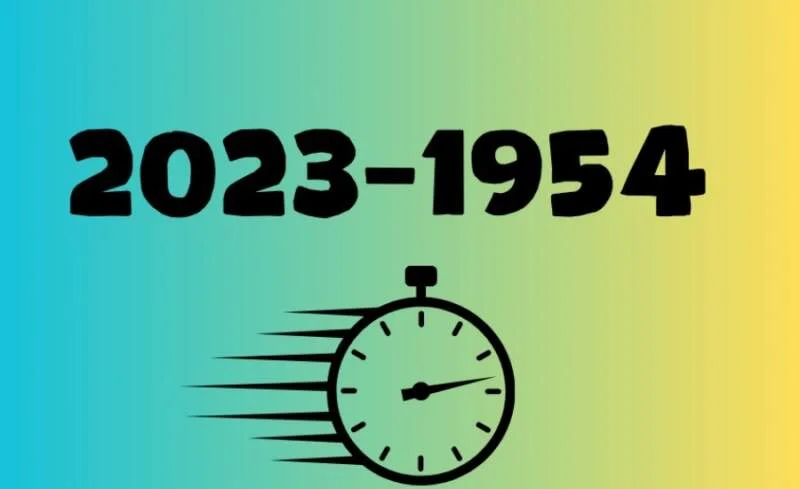The United States has undergone significant transformations between 1954 and 2023. Over nearly seven decades, the country has experienced massive shifts in its economy, technology, social fabric, education, healthcare, and global influence. This article will take you through these changes, showcasing the evolution of the United States in various domains and offering a glimpse of how things have drastically changed from the mid-20th century to the present day.
How the US Economy Transformed from 1954 to 2023
The American economy has seen remarkable growth and significant transformations between 1954 and 2023. In the 1950s, the US was emerging from World War II as a global superpower, with its economy booming. Industrial production was at an all-time high; the manufacturing sector was the backbone of the economy, and the country had an abundance of jobs in factories, steel mills, and assembly lines. The labour force was predominantly male, and wages were decent, allowing families to live comfortably on a single income. The US dollar was strong, and America was the leading exporter of goods worldwide.
Fast forward to 2023, and the US economy looks vastly different. The industrial economy has given way to a service-based and digital economy. While manufacturing has declined, sectors such as technology, finance, and healthcare have taken the lead. Automation and artificial intelligence (AI) play crucial roles in the workforce, changing how industries function. The gig economy is flourishing, with many Americans taking up freelance work, and entrepreneurship has seen a boom with the rise of tech startups. Globalization has made the US economy interconnected with the rest of the world, with trade playing a critical role. However, the disparity in wealth distribution has become a central issue, with income inequality widening significantly since the 1950s.
Technology: From Typewriters to Smartphones
In 1954, technology was in its infancy, and what we now consider basic technological advancements were either non-existent or in early developmental stages. Most offices and homes relied on typewriters for documentation, and telephones were simple, bulky devices with rotary dials. Television was black and white, and only a few households owned one. The concept of a personal computer was unimaginable for the average person.
In 2023, the US has become a global technology hub. The technological revolution has brought us from the humble typewriter to the sophisticated smartphone, an essential tool in daily life. The internet, introduced in the late 20th century, now dominates nearly every aspect of our existence, from communication and entertainment to education and business. Tech giants like Apple, Google, and Microsoft have revolutionized how we live and work, making computers, mobile devices, and software indispensable. Artificial intelligence, cloud computing, and quantum computing are pushing boundaries, opening up new possibilities for the future.
How Society and Culture Evolved in America
The social fabric of the United States has changed drastically between 1954 and 2023. In 1954, American society was highly segregated, with racial discrimination and gender inequality deeply entrenched in the system. The traditional nuclear family, with a working father and a stay-at-home mother, was the norm, and conservative social values dictated much of life.

By 2023, America had undergone a profound social transformation. Society is more inclusive, diverse, and progressive. Gender roles have evolved, and women now make up a significant part of the workforce, often outpacing men in higher education achievements. The LGBTQ+ community has gained substantial rights, with same-sex marriage legalized nationwide in 2015. Moreover, racial and ethnic diversity has increased significantly due to immigration and changing demographics.
The Civil Rights Movement and Its Impact
One of the most pivotal movements in American history, the Civil Rights Movement, began in earnest in the 1950s, fighting for racial equality and an end to segregation. Icons like Martin Luther King Jr. led the charge, advocating for nonviolent protests to dismantle the discriminatory laws that plagued the country. The movement had a profound and lasting impact, resulting in landmark legislation such as the Civil Rights Act of 1964 and the Voting Rights Act of 1965.
By 2023, the US has seen great strides toward racial equality, although challenges remain. African Americans, Latinos, Asians, and other minority groups have made significant political, social, and economic gains, contributing to the rich diversity that defines modern America.
The Digital Age: Social Media and Communication
The 21st century saw the birth of the digital age, where communication evolved rapidly. In 1954, long-distance communication was limited to letters or expensive long-distance phone calls. However, the rise of the internet and social media platforms such as Facebook, Twitter, and Instagram changed how Americans interact with each other and the world.
By 2023, social media had become a vital communication tool for individuals and businesses. It allowed instant connections across the globe and profoundly impacted culture, politics, and even social movements. Social media platforms have revolutionized how we consume news, entertainment, and information, making it easier for voices from all walks of life to be heard.
Popular Culture: Music, Movies, and Fashion
Popular culture in America has also undergone significant changes. In 1954, rock ‘n’ roll was in its early stages, with artists like Elvis Presley beginning to dominate the music scene. Fashion was conservative, with women often wearing dresses and men in suits for formal occasions. Movies were a major source of entertainment, with Hollywood at its golden age, and films were primarily watched in theatres.
By 2023, pop culture in the US is a reflection of the country’s diversity. Music genres such as hip-hop, pop, electronic, and country have taken over, and streaming platforms like Spotify and Apple Music have made accessing music easier than ever. Fashion has evolved from formal to more casual and diverse styles, with trends changing rapidly. The film industry is now dominated by blockbuster franchises, streaming services like Netflix and Disney+, and global influence.
Education and Healthcare Advancements
Education and healthcare in America have seen substantial growth between 1954 and 2023. In 1954, the education system was less inclusive, with racial segregation in schools being a reality, most notably highlighted by the landmark case of Brown v. Board of Education. Healthcare was basic, with fewer medical advancements, and most families relied on a family doctor for all medical needs.
By 2023, the landscape had changed dramatically. Schools are more inclusive, diverse, and equipped with technology, giving students access to a wealth of information and resources. Online education has surged in popularity, allowing people to learn from the comfort of their homes.
Healthcare has also seen incredible advancements, from the eradication of diseases like polio to cutting-edge treatments for cancer, heart disease, and other life-threatening conditions. With the advent of telemedicine, healthcare is now more accessible, allowing patients to receive medical consultations online. The development of vaccines, including the COVID-19 vaccine, has saved countless lives and shaped public health policies in profound ways.
The United States in Global Politics: 1954 vs 2023
In 1954, the US was solidifying its position as a global superpower after World War II, playing a dominant role in international politics. The Cold War was heating up, with tensions between the US and the Soviet Union influencing global affairs. America was involved in the Korean War and would soon enter the Vietnam War, with its foreign policy largely driven by the containment of communism.
In 2023, the US remains a major player on the global stage, but the nature of its involvement in world affairs has evolved. While it remains a military and economic powerhouse, emerging global powers like China have changed the geopolitical landscape. The US is heavily involved in diplomatic efforts, addressing climate change, global health crises, and cybersecurity threats, which have become major issues in international relations.
Environment and Sustainability Efforts
Concerns about the environment were relatively minimal in 1954, with industrial growth taking precedence over environmental conservation. Pollution, deforestation, and resource exploitation were rampant, with little regulation.

By 2023, environmental consciousness had grown significantly, with climate change becoming one of the most pressing issues of the time. The US has implemented various measures to reduce carbon emissions, protect endangered species, and promote renewable energy sources.
How the US Tackles Climate Change
The US government and private sector have invested heavily in sustainability and clean energy technologies. Policies promoting electric vehicles, wind farms, and solar energy have gained traction as part of efforts to reduce dependence on fossil fuels. However, the US still faces challenges in fully committing to climate goals, with debates continuing over the balance between economic growth and environmental protection.
How Did Life in the USA Change from 2023 to 1954?
Life in the USA has seen monumental shifts, from the rapid advancement of technology to the social, political, and economic changes that have shaped the modern-day country. The way Americans work, live, and interact with the world has transformed, offering a unique glimpse into the nation’s adaptability.
What Were Some Major Events in the USA from 1954 to 2023?
Key events that have shaped the US from 1954 to 2023 include the Civil Rights Movement, the moon landing in 1969, the end of the Cold War in 1991, the 9/11 attacks in 2001, and the global financial crisis in 2008. More recently, the COVID-19 pandemic and its aftermath have left a lasting impact on American life as the country continues to navigate challenges in health, economics, and politics.
What Were the Coolest Inventions from 1954 to 2023?
Some of the coolest inventions between 1954 and 2023 include the internet, personal computers, smartphones, GPS, artificial intelligence, and renewable energy technologies like solar panels. These innovations have transformed everyday life, making the world more connected, efficient, and sustainable.
The Bottom Line
The United States has changed dramatically between 1954 and 2023. From economic shifts and technological revolutions to societal progress and environmental efforts, America continues to adapt and evolve. Understanding these changes gives us insight into the forces that have shaped modern life and the direction the country may take in the future.




Leave a Reply